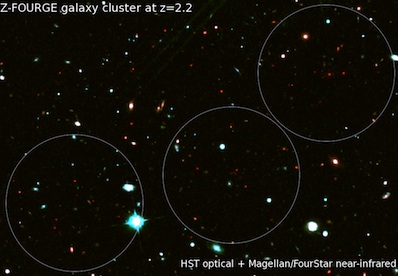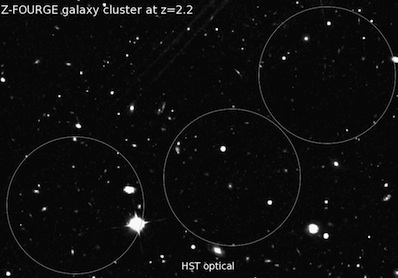


|

|
 |
|
Infrared camera reveals distant galaxy cluster DR EMILY BALDWIN ASTRONOMY NOW Posted: 08 March 2012 Astronomers using the FourStar camera on the 6.5 metre Magellan Baade Telescope in Chile have identified a mature 10.5 billion light year distant galaxy cluster that had evaded detection by other ground- and space-based observatories. The findings are part of the FourStar Galaxy Evolution Survey (“Z-FOURGE”) to determine distances of faint galaxies. While protoclusters of newly forming, young blue stars have already been identified at distances as great as 13.1 billion light years, the new discovery is thought to mark the most distant red – mature – galaxy cluster. "While all these objects have been named clusters, none of them actually remotely resemble galaxy clusters as we know them today – they usually consist of lightweight, blue galaxies," says Eric Persson of the Carnegie Observatories and who led the development of the new camera that enabled the new discovery. "The theoretical expectation is indeed that these systems may grow into massive galaxies clusters at later times, but it remains a large extrapolation. Our new cluster actually already contains massive red galaxies with mature stellar populations."   An infrared image of the cluster from FourStar (top), with colours balanced to accentuate the red galaxies at 10.5 billion light years, compared with a visible light image from the Hubble Space Telescope (bottom). Image: Z-FOURGE/Carnegie Observatories/HST. Located 10.5 billion light years away towards the constellation of Leo, the currently unnamed cluster comprises 30 closely packed galaxies. The cluster had previously evaded detection by the likes of the Hubble Space Telescope, but the sensitive near-infrared filters of FourStar allowed astronomers to accurately pinpoint the distances of thousands of galaxies, confirming the relationship between this particular grouping of 30 galaxies. "The camera uses a combination of filters that together act kind of like specialized sunglasses that filter out nearly all light, except light that is coming from objects a certain distance away," explains Spitler. "We used the FourStar camera to map out the distances to all galaxies in a small region on the sky. Once we did this, we discovered 30 galaxies at approximately the same distance in a very compact region of the sky. This meant the 30 galaxies were most likely physically related to each other (via gravitational forces) and make up a dense galaxy cluster. Before, other astronomers had observed the galaxies in the cluster, but they didn't have the critical distance information." The galaxy cluster will continue to grow into an extremely dense structure possibly containing thousands of galaxies. The confirmation of a red galaxy at just three billion years after the big bang will help shed light on how the first galaxies evolved and assembled into larger structures. "We are in the process of following up with big telescopes and spectrographs and comparing to theoretical models," adds Persson. "The hope is that it well tell us about how galaxy formation depends on the local galaxy density and environment." |
|
|
|
|